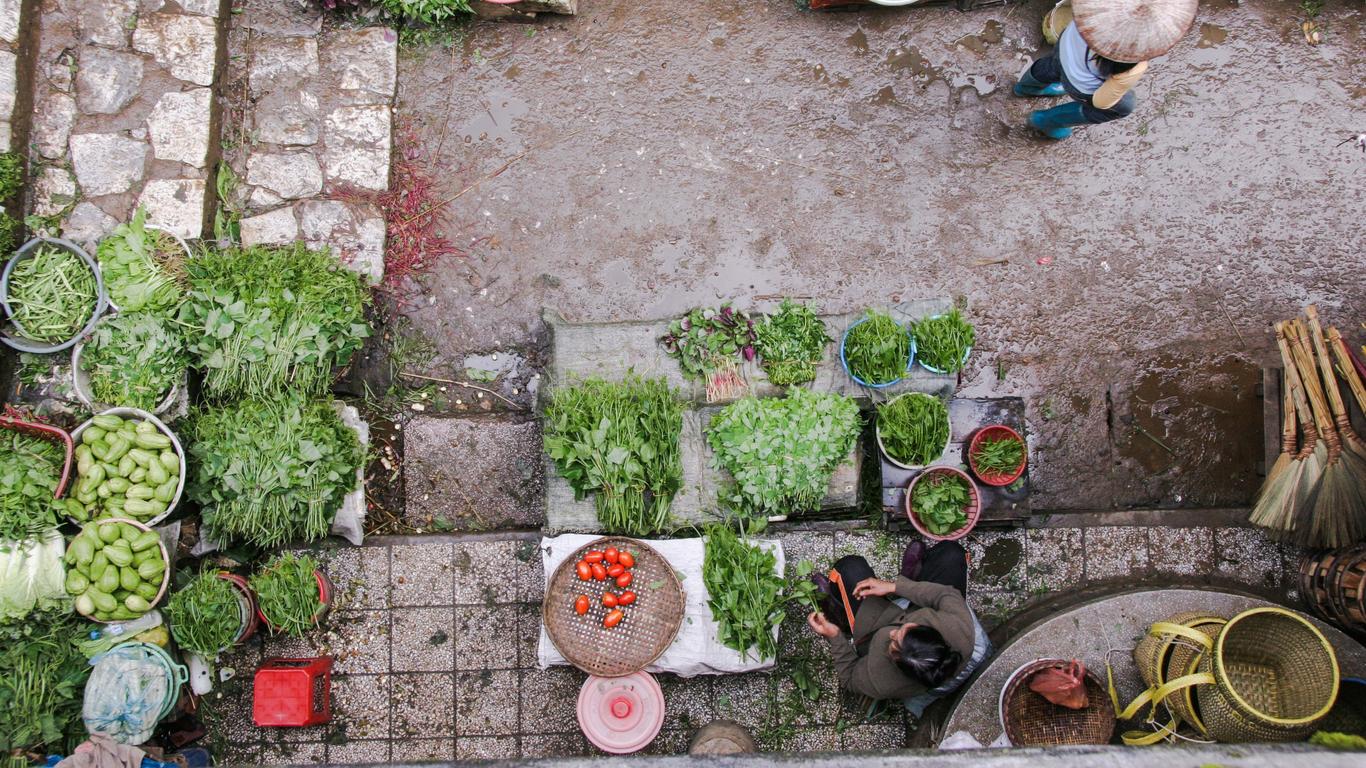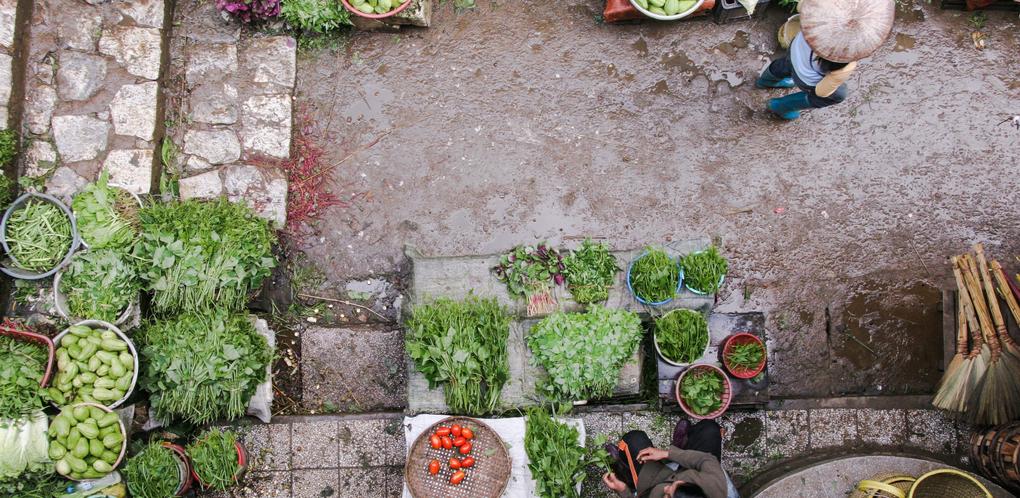
Sa Pa travel guide
Sa Pa Tourism | Sa Pa Guide
You're Going to Love Sa Pa
Nestled in the lush hills of northern Vietnam, Sa Pá is a beautiful small town that encircles a lake high in the mountains. A premier spot for trekking, biking, and relaxation, Sa Pá is home to numerous hill tribes.

Visiting Sa Pá is a great way to get away from bustling cities and into what remains of Vietnam's natural environments.
Top 5 Reasons to Visit Sa Pa
1. Village Treks
Sa Pá is filled with tour guides who will gladly take you off the beaten paths to visit hill tribes that live in conditions quite different from those of the city-dwellers.
2. Bustling Markets
Sa Pá is home to popular crafts markets that bring in villagers from the surrounding hills.
3. Amazing Food
A wide variety of Vietnamese cuisine is on offer in this town, including the ubiquitous pho.
4. Cascading Waterfalls
Travelers have the opportunity to visit nearby Hoang Lien National Park with its mighty waterfalls.
5. Mighty Mountains
Several of the highest mountains in Southeast Asia, such as Phan Xi Păng, are located in the vicinity of Sa Pá.
What to do in Sa Pa
1. An Ethnology Extravaganza
Start here to get an excellent overview of the history of the hill country, with its ethnic mosaic, and a distinctive culture that is worlds apart from the modern pace of life in the coastal cities. If you're unsure about what divides the Hmong from the Red Dao peoples, this is the place to find out, and it presents thousands of years of ethnology and archaeology in fascinating, albeit sometimes a little faded, fashion. Downstairs, there's a craft workshop, so there may be souvenir buying opportunities, too.
2. Souvenir Central
If you're after a heavy dose of mountain life, Sa Pa's Main Market is the place to head. It used to be located right at the center of town, but the authorities chose to clear out the heart of town, moving the traders to a new site not far from the station. But this didn't dent their enthusiasm for selling. Along with produce plucked straight from the ground (and plenty of butchered meat), the highlights here are handicrafts made by hill peoples - so take a bag big enough to cater for the folks back home.
3. Vietnamese Views To Die For
For tourists, much of the real action in Sa Pa starts when they leave the town itself and venture into the Vietnamese highlands, and for many people Tram Ton Pass is one of the first places they visit. Part of the highway between Sa Pa and Lai Chau, the pass rises to 1,900 meters, affording frankly amazing views across the valleys below. If you are looking for the best viewpoint of all, stop off at Thac Bac waterfall and get your camera ready.
4. Experience Authentic Vietnamese Hill Culture
Located around 10 miles outside Sa Pa, Ta Phin is a time capsule of a village set in a secluded valley covered in rice paddies, and fringed by mountains. In short, it's a sublime setting for a magical place. Be there in spring to hear the locals belting out their famous church singing, pick up some Dao embroidery with its rich orange and red colors, or bring a flashlight and explore Ta Phin Cave, which reputedly stretches for 10 miles. In any case, it's a place where you can't help relaxing and you can get there from Sa Pa by bike, motorbike, or on foot.
5. The Peak Of The Hoang Lien's Treasures
The crowning glory of the Hoang Lien Mountains, Fansipan has a distinctive narrow pyramid shape and is the highest mountain in all of Vietnam. Naturally, climbing it is an attraction for hardcore climbers, but everyday hikers can still make the most of the mountain, even without crampons and helmets. That's because a new cable car has been installed, which ascends an impressive 6,200 meters to near the summit. Alternatively, you can hike there in two days from Sa Pa, and guides are available for hire in town. If you are venturing onto the high slopes, their services are definitely recommended.
1. An Ethnology Extravaganza
Start here to get an excellent overview of the history of the hill country, with its ethnic mosaic, and a distinctive culture that is worlds apart from the modern pace of life in the coastal cities. If you're unsure about what divides the Hmong from the Red Dao peoples, this is the place to find out, and it presents thousands of years of ethnology and archaeology in fascinating, albeit sometimes a little faded, fashion. Downstairs, there's a craft workshop, so there may be souvenir buying opportunities, too.
2. Souvenir Central
If you're after a heavy dose of mountain life, Sa Pa's Main Market is the place to head. It used to be located right at the center of town, but the authorities chose to clear out the heart of town, moving the traders to a new site not far from the station. But this didn't dent their enthusiasm for selling. Along with produce plucked straight from the ground (and plenty of butchered meat), the highlights here are handicrafts made by hill peoples - so take a bag big enough to cater for the folks back home.
3. Vietnamese Views To Die For
For tourists, much of the real action in Sa Pa starts when they leave the town itself and venture into the Vietnamese highlands, and for many people Tram Ton Pass is one of the first places they visit. Part of the highway between Sa Pa and Lai Chau, the pass rises to 1,900 meters, affording frankly amazing views across the valleys below. If you are looking for the best viewpoint of all, stop off at Thac Bac waterfall and get your camera ready.
4. Experience Authentic Vietnamese Hill Culture
Located around 10 miles outside Sa Pa, Ta Phin is a time capsule of a village set in a secluded valley covered in rice paddies, and fringed by mountains. In short, it's a sublime setting for a magical place. Be there in spring to hear the locals belting out their famous church singing, pick up some Dao embroidery with its rich orange and red colors, or bring a flashlight and explore Ta Phin Cave, which reputedly stretches for 10 miles. In any case, it's a place where you can't help relaxing and you can get there from Sa Pa by bike, motorbike, or on foot.
5. The Peak Of The Hoang Lien's Treasures
The crowning glory of the Hoang Lien Mountains, Fansipan has a distinctive narrow pyramid shape and is the highest mountain in all of Vietnam. Naturally, climbing it is an attraction for hardcore climbers, but everyday hikers can still make the most of the mountain, even without crampons and helmets. That's because a new cable car has been installed, which ascends an impressive 6,200 meters to near the summit. Alternatively, you can hike there in two days from Sa Pa, and guides are available for hire in town. If you are venturing onto the high slopes, their services are definitely recommended.
Where to Eat in Sa Pa
Sa Pá has many restaurants that cater to everyone from the luxury traveler to the local. A dinner purchased at a restaurant will usually cost about ₫70,000 at a modest establishment. Popular eateries include Little Sapa, Bombay Indian, and Hill Station Signature Restaurant.
When to visit Sa Pa
A highly seasonal climate brings snow to the peaks above town during cold winters. The wet season lasts from May to September, making March, April, and October the best months to visit.
How to Get to Sa Pa
Plane
There is no airport near Sa Pá, so international travelers should fly to Nội Bài International Airport (HAN) in Hanoi and take a train or bus into town (see below).
Train
A nine-hour train journey runs to Sa Pá from Hanoi. Carriages are operated by both national and private entities and the best way to avoid getting ripped off is to buy tickets at the station. Soft seats cost ₫220,000, while soft sleepers charge twice that.
Car
The roads in Vietnam are of high quality, but the traffic is dangerous. Foreigners can drive in the country if they have an International Driver's License but this must be accompanied with local insurance.
Bus
Numerous bus operators reach Sa Pá, including Sapa Express. A night bus from Hanoi should cost around ₫34,0000.
Airports near Sa Pa
Airlines serving Sa Pa
Where to stay in Sa Pa
The old town has many cheap hostels - one highly rated option is the MiKu Chill House. Other options in town include Khach San Hoang Ha and the plush Chau Long Sapa Hotel.
Where to stay in popular areas of Sa Pa
Most booked hotels in Sa Pa
How to Get Around Sa Pa
Public Transportation
Sa Pá is entirely walkable and there is no public transport.
Taxi
There are several taxis in Sa Pá, as well as moto-taxis, which operate for a negotiated price that varies wildly. It shouldn't cost more than ₫15,000 to get across town.
Car
Renting a car with driver in town is possible but can be expensive, with prices around ₫4,315,850 per day. Those looking for their own form of transport would do well to opt for a motorcycle under 115cc instead.
The Cost of Living in Sa Pa
Shopping Streets
Simacai Market is a wonderful place for those interested in local crafts and customs. Embroidery is a well-loved local product. Costs vary significantly in Sa Pa, and you should expect prices significantly higher than elsewhere in Vietnam because of its touristy nature.
Groceries and Other
Produce is often sold at local markets. Expect to pay about ₫5,000 for local fruit like rambutan, while bread costs about the same for a freshly baked baguette.
